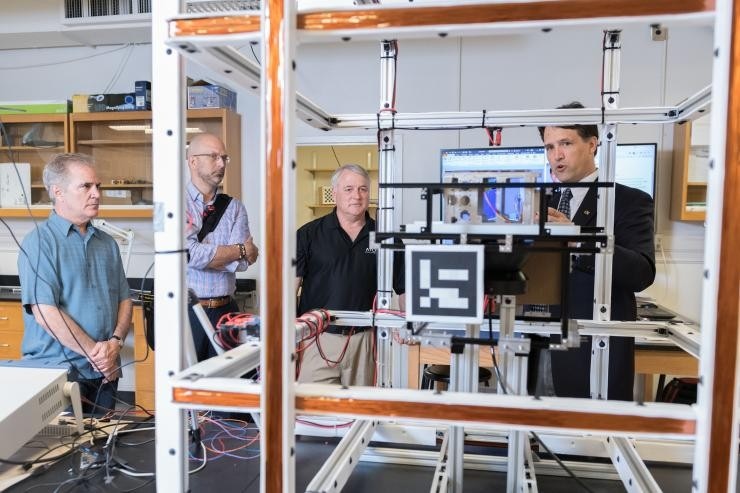Jun 26 2018
 Brian Gunter, assistant professor in Georgia Tech’s Guggenheim School of Aerospace Engineering, shows the small satellite testing facilities in his lab to Xenesis leadership. Shown (l-r) are Neal Campion, Xenesis Strategy Director; Mark LaPenna, Xenesis CEO and founder; Mike Carey, chief strategy Officer at Atlas Space Operations, and Gunter. (Credit: Allison Carter, Georgia Tech)
Brian Gunter, assistant professor in Georgia Tech’s Guggenheim School of Aerospace Engineering, shows the small satellite testing facilities in his lab to Xenesis leadership. Shown (l-r) are Neal Campion, Xenesis Strategy Director; Mark LaPenna, Xenesis CEO and founder; Mike Carey, chief strategy Officer at Atlas Space Operations, and Gunter. (Credit: Allison Carter, Georgia Tech)
A new research project formed recently by a partnership between the Georgia Institute of Technology and satellite communications provider Xenesis could help free up the bottleneck that presently restricts the transmission of data from Earth-orbiting satellites to ground stations.
The project will miniaturize, space qualify, and test a laser communications transceiver that could significantly expand the bandwidth available for downlinking information from the increasing number of satellites—and future constellations of space vehicles—in low Earth orbit. Xenesis has licensed the technology from NASA’s Jet Propulsion Laboratory (JPL), and will partner with Georgia Tech and JPL to develop it for use as the main communication system for satellites as small as CubeSats.
We expect to significantly add to the total bandwidth of information that we can get down from space, and the more bandwidth we have, the more information we can exchange and the more value we can get from satellite networks.
Brian Gunter, Assistant Professor, Daniel Guggenheim School of Aerospace Engineering, Georgia Tech
Gunter’s lab has worked with small satellites and will apply that skill set to the project with Xenesis—which signed a $1.2 million contract on June 14 to assist the project. Georgia Tech’s contribution will be to miniaturize the novel JPL technology, modernize the control software, space qualify all the hardware, and test the enhanced system from space—probably from the International Space Station.
With all of the satellites that are going into space, everything from CubeSats to major satellites, there is more information being generated than can ever be downloaded. Most of today’s systems depend on radio frequency downlinks, and there is just a limited amount of bandwidth available for use.
Dennis Poulos, Chief Technology Officer, Xenesis
Laser-based systems can expand that bandwidth to more than 10 gigabits per second, Poulos said. Besides increasing bandwidth, optical systems can employ smaller antennas, use power more efficiently, and provide improved data security.
Mark LaPenna, CEO of Xenesis, compared the advantages of the planned space-based network to the hike in performance from terrestrial dial-up connections of the 1990s to present-day high-speed broadband services.
Xenesis recognizes the need for a global communications revolution, and we plan to empower space with an optical product called XenHub. Through this architecture, any company, mission or global operator on the ground or in space, will be able to compete on a level playing field for the first time since Sputnik.
Mark LaPenna, CEO, Xenesis
The laser communications transceiver created by JPL consists of two parts: (1) an optics module that includes a two-axis gimbal, five-centimeter telescope, monitoring sensors, and thermal control system, and (2) an electronics module with a transmitter, controllers, processor, and power conditioning systems.
Though it is exposed to cloud interference, the laser system will gain from creating a narrow beam that can travel farther than analogous radio-frequency transmissions at the same power level.
The primary focus will be space-to-ground communication, though the system could also be employed for cross-linking communication between satellites. The small antenna size is also more ideal to the small-form satellites intended for future constellations that may include numerous spacecraft.
Once we can show that this works from space to ground, that will demonstrate that the technology can survive the harsh environment of space, and allow us continue the development of the transceiver for commercial use. This has the potential to open up a range of new capabilities, including the ability to provide high-volume data services to anywhere in the world. This will be a major satellite project for our lab, and we look forward to advancing the technology with our collaborators.
Brian Gunter, Assistant Professor, Daniel Guggenheim School of Aerospace Engineering, Georgia Tech